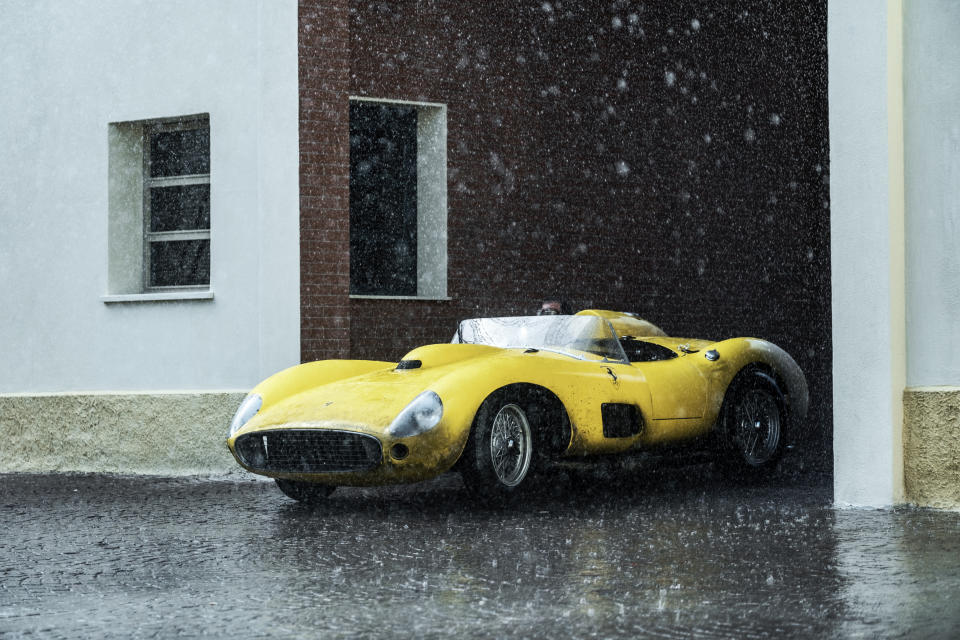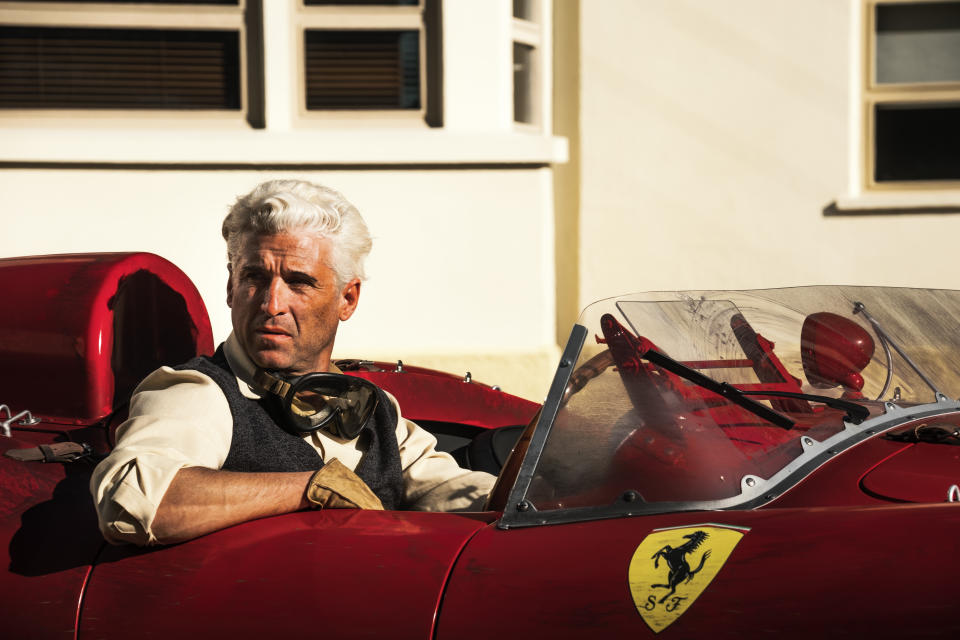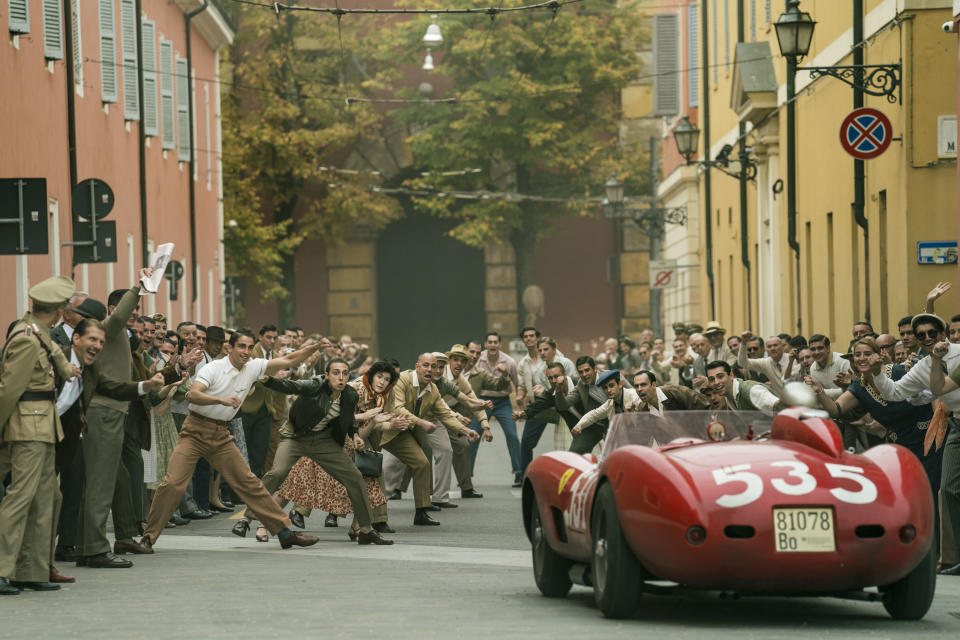The Cars — and the Speed — Are Real in Michael Mann’s ‘Ferrari’
A lot of directors make great movies -- but Michael Mann[1] creates great experiences, films that give the audience an almost tactile sense of what his characters are feeling and thinking down to the smallest perceptible detail. In his debut feature "Thief[2]" he took the viewer through every aspect of safecracking, from the tools and the process to the precise cocktail of emotions the title character felt in both moments of success and catastrophic failure. In "Manhunter," Mann found visual and aural corollaries for the experience of an FBI profiler putting himself in the mindset of a serial killer, persuading the viewer to link their perspective to that of the profiler in the same way the profiler was linking his to his subject.
Mann's greatest film, "Heat[3]," takes the raw materials of a cops-and-robbers action flick and approaches them so realistically that it takes three hours to cover all the ground necessary -- yet there isn't a moment in the film that doesn't pulse with propulsive emotion and action. Mann's latest movie, "Ferrari" (in theaters Christmas Day), is typical of his oeuvre -- in fact, in its ability to convey the exhilaration and terror of racing in the 1950s, it's one of his most sensationally visceral works to date. Mann creates two contrasting styles for the complementary narrative threads, telling a muted, classically composed story whenever the movie focuses on title character Enzo Ferrari (Adam Driver) and his fraught personal life, and shifting into a much more frenetic gear for the film's kinetic and often terrifying racing sequences.
When thinking about the contrast between the two styles, Mann asked himself a question similar to the ones he expects his actors to explore. "What's my action? Meaning, how do I want that to impact on an audience," Mann told IndieWire. "And I want [the racing] to be the exact counterpoint. I want it to be savage, and for you to experience not looking at a car -- meaning being a removed observer of a beautiful shot with a long lens -- but being in the driver's seat."
Story continues More from IndieWire Giving the audience a sense of what Mann calls "the intense agitation" of being in the thick of a race meant that everything had to be filmed for real, with real cars on real tracks. "There's no green screen.
There's no video wall," cinematographer Erik Messerschmidt said. "Michael was not interested in shooting the car at 50 miles an hour and then playing all the camera tricks to make it look like it's going a hundred. He was interested in shooting the cars at 100 miles an hour." Messerschmidt noted that avoiding the typical tricks in which lenses and careful camera positioning make it look like the cars are going faster than they actually are created a number of logistical challenges. "There are safety challenges and camera rigging concerns. We had to build the cars and the camera rigs so that they could sustain G forces and vibration."

"Ferrari" Real Ferraris from the era depicted in Mann's film are extremely expensive collector's items that can sell for tens of millions of dollars on the open market, so the filmmakers' first task was to create convincing replicas. (One exception: a classic Maserati owned by Pink Floyd drummer Nick Mason that was loaned to the production.) Mann collaborated with stunt coordinator Robert Nagle and vehicle supervisor Neil Layton to build replicas from scratch. "They had to go 140 or 150 miles per hour, had to be reliable, and had to be safe," Mann said. Starting with 3D LiDAR scans of actual cars, Mann's team reproduced what Mann called "mathematically perfect" bodies of the vehicles according to the director's scrupulous demand for authenticity. "All the trim and details are absolutely accurate," Nagle said. "Then it was a matter of finding a good base chassis to start with without having to re-engineer everything."
Layton and Nagle landed on a supercharged four-cylinder Caterham 620 at 340 horsepower, resulting in cars that weighed around 1,800 pounds. "They were rockets," Nagle said. Creating fast and reliable cars was the first step; the second was figuring out how to shoot them. Messerschmidt, Nagle, and Layton collaborated on a variety of approaches depending on the demands of any given shot, sometimes using rigs mounted to the cars, sometimes using high-speed camera cars to drive alongside the picture cars, or relying on helicopters or high-speed drones to capture the action. "It began with the LiDAR scan," Mann said. "That went into a CAD computer program, and we then reverse engineered the design of the tubular chassis.
Into the tubular chassis we built hard mount points so that I could penetrate through the skin of the car and attach tracking camera systems to the actual chassis." That gave Mann maximum flexibility when shooting his driving scenes. "We were able to have devices where a camera could run up the side of the car, pan to the car, to the right to see a neighboring car, and come back around and be in a close-up on the driver of that car," Mann said, "and be moving, and all of that could be happening while the car was going 110, 115 miles an hour." At other points the makers of "Ferrari" relied on less elaborate techniques. "Some of it is handheld, with camera operator Roberto De Angelis sitting in the passenger seat," Mann said. For scenes in which the acting was central, Nagle used what he called a "biscuit rig." "It's a drivable platform you can put the car on and it allows you to mount cameras pretty much anyplace you want," Nagle said. "It'll run at the speed that the cars run so we can stay in the mix and have the actors act without worrying about driving."

"Ferrari" One actor in particular was up to the challenge, however. Patrick Dempsey, who plays Italian racing legend Piero Taruffi, is himself an experienced race car driver and was more than game for anything Nagle could throw at him. "He did a fantastic job," Nagle said. "All I had to do was turn him loose and put cameras on him.
He was so capable that I actually had him listed on the stunt team." For all of the actors, there was an intense training period to make sure that they could be convincing and seamlessly match the action of the stunt drivers. "We train them to a level where they feel confident on camera, so they can drive the car with authority and there's no tell that they're not actually that capable." The final step in conveying the visceral experience of racing the cars "Ferrari" depicts came in the sound design, for which Mann brought in an ace team of collaborators: production sound mixer Lee Orloff, re-recording mixer & supervising sound editor Tony Lamberti, supervising sound editor Bernard Weiser, and re-recording mixer Andy Nelson. Together they created a soundscape both painstakingly accurate and emotionally evocative, seamlessly mixing production sound from the actual races with recordings of rare period cars (many of them borrowed from Nick Mason's collection) to place the viewer at the center of the action.
Lamberti noted that he and Mann spotted all of the races scrupulously, figuring out exactly what type of sound was needed for every shot and then slipping in the correct effect as the recordings of the real vehicles came in. Once again Mann's demand for realism created challenges, particularly for Orloff when it came to recording dialogue on set. "On Michael's set, if you've got cars coming and going, they're running all the time," he said. "There's no asking to shut off the engines or anything like that." While the sound team stuck to Mann's overall guiding principle of sticking as close to reality as possible, one of the film's most striking emotional effects comes in a crash sequence where they went for a more impressionistic approach, dropping the sound out bit by bit and replacing it with a dull vibrating sound that lets the horror of what is happening settle in. For Mann, it was a moment designed to illustrate just how dangerous the cars he's presenting were. "These were incredibly powerful cars that, nevertheless, didn't have current technology for braking and safety," he said.
Like Dempsey, Mann has raced cars himself -- he raced on and off in the Ferrari Challenge from the late '90s to the mid-2000s -- and his experience undeniably informs the set pieces in "Ferrari," which are among the best of their type ever put on film. "When it's happening the right way, you, the vehicle, you're all one. It's a unified organism. Your focus is 100 percent, you're not concerned about what's happening back in Los Angeles.
There's a kind of zen feeling like when you were 11 years old and had a dream of flying, or had this idea, 'I'm Peter Pan,' or whatever. It's very analogous to that." NEON will release "Ferrari" in theaters nationwide December 25.
Best of IndieWire
Sign up for Indiewire's Newsletter[4].
For the latest news, follow us on Facebook[5], Twitter[6], and Instagram[7].
